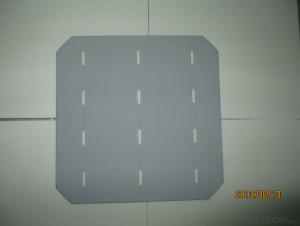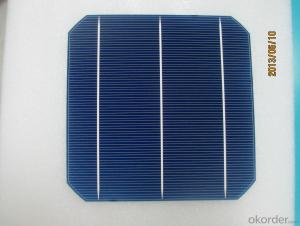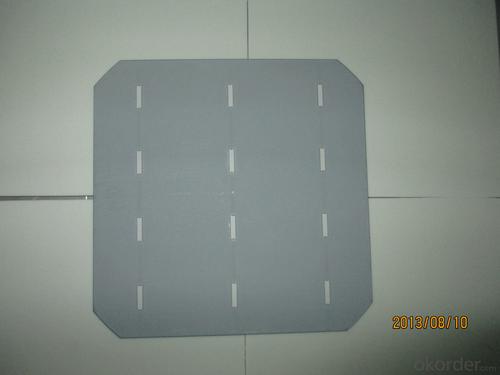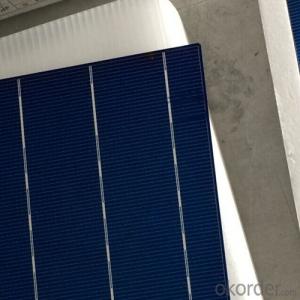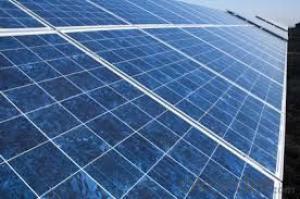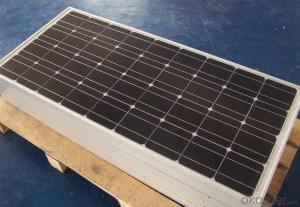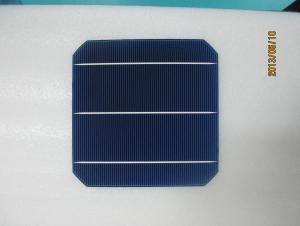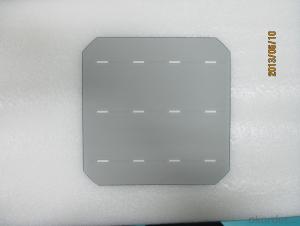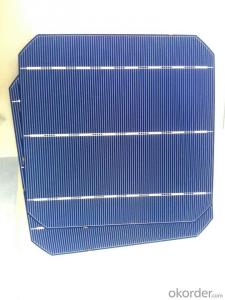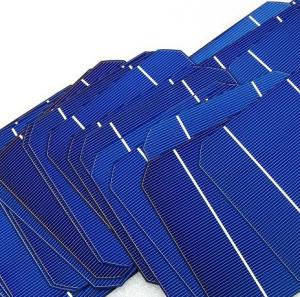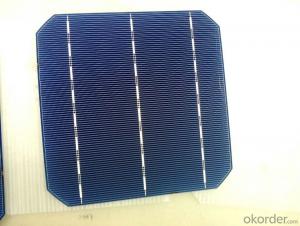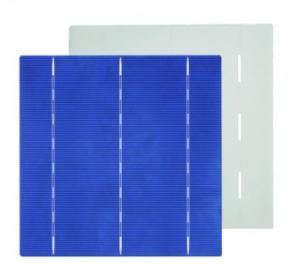High Efficiency 156*156mm Monocrystal Solar Cell for Solar Energy Materials and Solar Cells
- Loading Port:
- Shanghai
- Payment Terms:
- TT or LC
- Min Order Qty:
- 1000 pc
- Supply Capability:
- 20000000 pc/month
OKorder Service Pledge
OKorder Financial Service
You Might Also Like
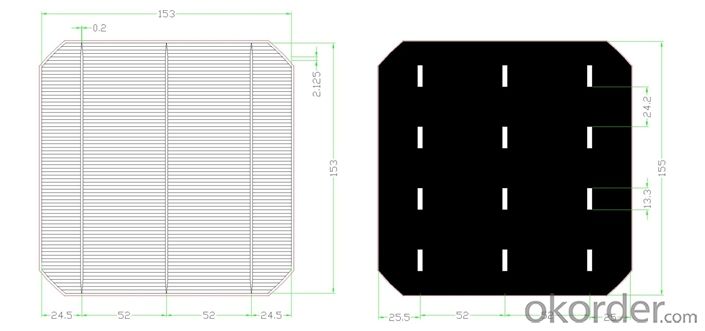
Monocrystal solar energy cell
Type:156M
Appearance:156×1565㎜±0.5mm; Diagonal:R=100mm
Main fence wide:1.4-1.5mm Back electrode wide:2-2.5mm
Fence line qty:90
Cell thickness:220um±20um
Eff(%) | 18.50- 18.60 | |||||||||||
Pm(W) | 4.48 | |||||||||||
Isc(A) | 8.84 | |||||||||||
Im(A) | 8.36 | |||||||||||
Voc(V) | 0.634 | |||||||||||
Vm(V) | 0.536 | |||||||||||
FF(%) | 79.3 |

remark:our company cells as per working current concentrate principle,separate the first and the second grade
Usage of Polycrystalline Solar Cells
Solar cells are often electrically connected and encapsulated as a module. Photovoltaic modules often have a sheet of glass on the front (sun up) side, allowing light to pass while protecting the semiconductor wafers from abrasion and impact due to wind-driven debris, rain, hail, etc. Solar cells are also usually connected in series in modules, creating an additive voltage. Connecting cells in parallel will yield a higher current; our solar cells have passed IEC Certification. With high and stable quality, our cells can greatly improve the performance of Solar Modules.
Factory Picture of Solar Cells
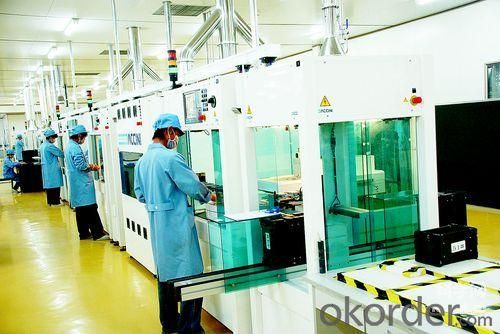
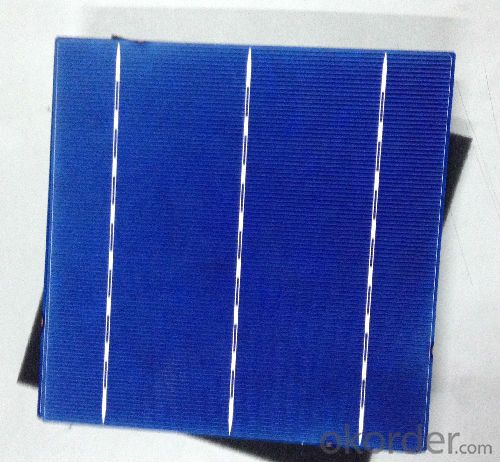
FAQ
We have organized several common questions for our clients,may help you sincerely:
What’s price per watt?
A: It’s depends on the quantity, delivery date and payment terms of the order. We can talk further about the detail price issue. Our products is high quality with lower price level.
Can you tell me the parameter of your solar cells?
We have different series of cells with different power output, both from c-si to a-si. Please take our specification sheet for your reference.
How do you pack your products?
We have rich experience on how to pack the panels to make sure the safety on shipment when it arrives at the destination.
Can you do OEM for us?
Yes, we can.
How long can we receive the product after purchase?
In the purchase of product within three working days, We will arrange the factory delivery as soon as possible. The perfect time of receiving is related to the state and position of customers. Commonly 7 to 10 working days can be served
- Q: How do solar cells handle partial shading?
- Solar cells handle partial shading by using bypass diodes. These diodes help redirect the flow of current around shaded areas, minimizing the impact of shading on the overall system performance.
- Q: Can solar cells be used for powering navigation buoys?
- Yes, solar cells can be used for powering navigation buoys. Solar cells are a reliable and sustainable source of energy that can generate electricity from sunlight, making them ideal for remote locations such as navigation buoys. They can effectively power the lighting and other electrical systems on the buoys, eliminating the need for traditional power sources and reducing maintenance costs.
- Q: Are solar cells recyclable?
- Yes, solar cells are recyclable. They contain valuable materials like silicon, glass, and metal, which can be extracted and reused. Recycling solar cells helps reduce waste and conserves resources.
- Q: What is the impact of saltwater exposure on solar cell efficiency?
- Saltwater exposure can have a significant negative impact on solar cell efficiency. The saltwater can corrode the metal components of the solar cells, leading to a decrease in their performance and overall efficiency. Additionally, the saltwater can create a conductive pathway that can bypass the solar cells, resulting in a loss of electrical energy. Therefore, it is crucial to protect solar cells from saltwater exposure to maintain their efficiency and prolong their lifespan.
- Q: What is the current situation and the recent progress space solar cells in China?
- Because the power supply system is one of the important subsystems of the satellites, they need to be configured with a suitable, reliable power subsystem. The proportion of the power subsystem in the whole satellite system is the highest, so the research on the power supply system is very important.
- Q: What is the solar cell?
- When the surface of the solar cell and the electrode on the back side are connected with each other, a current flows.
- Q: Can solar cells be used in swimming pool heating?
- Yes, solar cells can be used in swimming pool heating. By capturing sunlight and converting it into electricity, solar cells can power a pool heating system, providing an eco-friendly and cost-effective way to warm up the pool water.
- Q: How do solar cells affect the local ecosystem?
- Solar cells have a minimal impact on the local ecosystem compared to traditional energy sources. They produce clean and renewable electricity, reducing the reliance on fossil fuels and their associated pollution. While the manufacturing and disposal of solar cells may have some environmental impact, it is far outweighed by the benefits of using solar energy, such as reduced greenhouse gas emissions and improved air and water quality. Additionally, solar installations can provide habitat for certain wildlife species and contribute to the preservation of natural landscapes. Overall, solar cells have a positive effect on the local ecosystem by promoting sustainability and mitigating climate change.
- Q: Can solar cells be used in agricultural irrigation systems?
- Yes, solar cells can be used in agricultural irrigation systems. Solar-powered irrigation systems harness energy from the sun to power water pumps, allowing the efficient distribution of water to crops. This renewable energy solution reduces reliance on traditional electricity sources, making it a sustainable and cost-effective option for agricultural irrigation.
- Q: Can solar cells be used in weather monitoring systems?
- Yes, solar cells can be used in weather monitoring systems. Solar cells can generate electricity from sunlight, which can be used to power various components of weather monitoring systems such as sensors, data loggers, and communication devices. This allows for remote and autonomous operation of these systems, making solar cells an ideal and sustainable power source for weather monitoring applications.
Send your message to us
High Efficiency 156*156mm Monocrystal Solar Cell for Solar Energy Materials and Solar Cells
- Loading Port:
- Shanghai
- Payment Terms:
- TT or LC
- Min Order Qty:
- 1000 pc
- Supply Capability:
- 20000000 pc/month
OKorder Service Pledge
OKorder Financial Service
Similar products
Hot products
Hot Searches
Related keywords
